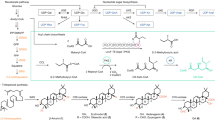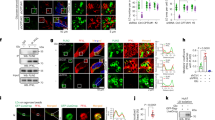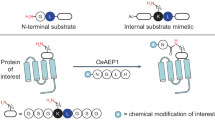Abstract
Two isozymes for human acyl-coenzyme A:diacylglycerol acyltransferase (DGAT), DGAT1 and DGAT2, were independently expressed in DGAT-deficient Saccharomyces cerevisiae to establish DGAT1- and DGAT2-S. cerevisiae. The selectivity of DGAT inhibitors of natural origin towards the isozymes was assessed in enzyme assays using the microsomal fractions prepared from DGAT1- and DGAT2-S. cerevisiae. Amidepsines and xanthohumol inhibited DGAT1 and DGAT2 with similar potency, whereas roselipins were found to inhibit DGAT2 selectively.
Similar content being viewed by others
Introduction
Triacylglycerol (TG) is the major energy-storage form of long-chain fatty acids in animals.1, 2 TG synthesis is important in many biological processes, including intestinal fat absorption, fat storage in adipocytes and energy metabolism in muscle, but excessive accumulation of TG in adipocytes as a result of a fat-rich diet or sedentary lifestyle causes obesity.
Acyl-coenzyme A (CoA):diacylglycerol acyltransferase (DGAT, EC2.3.1.20) is a membrane-bound enzyme that catalyzes TG formation by acyl esterifications of diacylglycerol. Two biological pathways for TG synthesis, the glycerol phosphate pathway and the monoacylglycerol pathway, have been reported. These pathways form diacylglycerol (DG), which in turn is acylated by DGAT to form TG.3 Recent molecular biological studies have revealed the existence of two different DGAT isozymes, DGAT1 and DGAT2,4, 5, 6 in mammals, and extensive studies including biological experiments and knockout mice have shown that these isozymes have different functions in mammals.7, 8, 9, 10, 11, 12, 13 Increased DGAT2 activity in the liver causes hepatic steatosis, whereas DGAT1 plays a role in very low-density lipoprotein (VLDL) synthesis in the liver and increases plasma VLDL concentration. Furthermore, newborn DGAT2-deficient mice die within hours of birth, whereas DGAT1-deficient mice are viable and have a modest reduction in tissue TG. Therefore, it is important to determine the selectivity of inhibitors towards the two DGAT isozymes for developing them as pharmaceutical drugs.
Our research group conducted an enzyme assay involving rat liver microsomes to discover several DGAT inhibitors from natural sources, including fungal amidepsins,14, 15, 16 plant xanthohumols17 and fungal roselipins18, 19, 20 (Figure 1). The selectivity of these inhibitors towards the two DGAT isozymes could not be assessed in the rat liver system. In this study, enzyme-based assay systems for DGAT1 and DGAT2 isozymes were established by transforming DGAT-deficient Saccharomyces cerevisiae using complementary DNA (cDNA) of human DGAT isozymes, which allowed us to investigate the selectivity toward the isozymes of natural DGAT inhibitors discovered earlier.
Materials and methods
Materials
Amidepsines A–D and roselipins 1A, 1B, 2A and 2B were purified from the culture broth of the respective microorganism according to established methods.14, 18 Xanthohumol was purified from the methanol extracts of Humulus lupulus according to an established method.17 [1-14C]Palmitoyl-CoA was purchased from GE Healthcare UK Ltd (Amersham Place, Little Chalfont, UK).
General
Standard molecular biological techniques were applied21. For polyethylene glycol-mediated transformation of yeast cells, the lithium acetate method was used.22
Strains, media and chemicals
S. cerevisiae BY4742-DGA1, a DGAT-deficient mutant of S. cerevisiae BY4742 (MATα his3 leu2 lys2 ura3), was purchased from Open Biosystems (Huntsville, AL, USA) (www.openbiosystems.com). S. cerevisiae OP3-C (MATα leu2 ura3) was used for the reference strain of DGAT activity. Escherichia coli strain DH5α (F− Φ80dlacZ ΔM15 Δ (lacZYA-argF) U169 deoR recA1 endA1 hsdR17 (rk−, mk+) phoA supE44 λ− thi-1 gyrA96 relA1) was used in DNA manipulations. YPD medium (1.0% bacto-yeast extracts, 2.0% bacto-peptone, 2.0% glucose) was used to grow non-transformed yeast strains. Selection medium (SM-Glc; yeast nitrogen base w/o amino acids 0.67%, cassamino acid 0.5%, glucose 2.0%) was used for the maintenance of yeast strains transformed with pYES, harboring either no insert or DGAT1 or DGAT2 cDNA. Production medium (PM-Gal; yeast nitrogen base w/o amino acid 0.67%, cassamino acid 0.5%, galactose 2.0%) was used for production of the recombinant human DGAT isozymes by the transformed yeasts.
Plasmids
The coding regions of human DGAT1 (accession no. AF059202) and DGAT2 (accession no. AY358532) genes were amplified using cDNA prepared from HeLa cells and a human liver cDNA library (Takara Bio Inc., Shiga, Japan), respectively, by polymerase chain reaction (PCR) (30 cycles, 1 min at 94 °C, 1 min at 55 °C and 6 min at 68 °C) using the following oligonucleotide sets: N-terminal primer 5′-GGG GAC AAG TTT GTA CAA AAA AGC AGG CTC CAT GGG CGA CCG CGG CAG C-3′ and C-terminal primer 5′-GGG GAC CAC TTT GTA CAA GAA AGC TGG GTA GCT CAG GCC TCT GCC GCT G-3′ for DGAT1, and N-terminal primer 5′-GGG GAC AAG TTT GAT CAA AAA AGC AGG CTC CAT GAA GAC CCT CAT AG-3′ and C-terminal primer 5′-GGG GAC CAC TTT GTA CAA GAA AGC TGG GTG CAG CTG GTT CCT CCA GG-3′ for DGAT2. The DGAT1 and DGAT2 cDNAs were transferred to pDONR201 (Invitrogen, Carlsbad, CA, USA) between the att1 and att2 sites by site-specific recombination according to the protocols, and the nucleotide sequences of the cDNA regions were determined by a PRISM 3100 Genetic Analyzer (Applied Biosystems) using M13 Primer M4 and M13 Primer RV (Takara Bio). The cDNAs were then transferred to pYES-DEST52 (Invitrogen) according to the manufacturer's protocols. The vector carried the URA3 marker for auxotrophic selection and a GAL1 promoter for protein expression.
Expression of the recombinant DGAT1 and DGAT2 in yeasts and preparation of microsomes
S. cerevisiae BY4742-ΔDGA1 transformed with pYES, harboring either no insert or DGAT1 or DGAT2 cDNA (designated as mock S. cerevisiae, DGAT1-S. cerevisiae and DGAT2-S. cerevisiae, respectively), was grown for 24 h in SM-Glc medium. The cells were washed twice with PM-Gal, resuspended in the same medium at OD590 nm=0.4 and grown for another 24 h. The cells were washed once with ice-cold PBS(−) and resuspended in DGAT buffer containing 50 mM Tris–HCl, 140 mM KCl, 0.1 mM EDTA (pH 7.5) and complete Mini (F. Hoffmann-La Roche AG, Basel, Switzerland). Cell lysates obtained by disintegration using a French Press (GLEN MILLS INC., Clifton, NJ, USA) were centrifuged at 15 000 g for 30 min. The supernatant was collected and centrifuged at 105 000 g for 1 h to precipitate the microsomes. The pellet was resuspended in DGAT buffer and the protein concentration was determined by a BCA protein assay kit (Thermo Fisher Scientific Inc., Rockford, IL, USA). The microsomes were aliquoted and frozen at −80 °C.
DGAT assay
Microsomal fractions from mock, DGAT1- and DGAT2-S. cerevisiae were used to measure DGAT activity. Assays were performed in duplicate as described previously.14 An assay mixture contained 175 mM Tris–HCl (pH 8.0), 50–75 μg yeast microsomal protein, 14.5 μM bovine serum albumin, [1-14C]palmitoyl-CoA (30 μM, 7.4 kBq), 8 mM MgCl2, 2.5 mM diisopropylfluorophosphate and 150 μM 1,2-dioleoyl-sn-glycerol; experimental inhibitors were dissolved in 2.5 μl of methanol and included in a total assay reaction volume of 0.2 ml. The assay was initiated by addition of the microsomal fraction. After incubation at 23 °C for 15 min, the reaction was stopped by addition of 1.2 ml of chloroform: methanol (1:2) and lipids were extracted according to the method of Folch et al.23 TG was separated by TLC on Silica gel 60 plates (Merck Co.) using a petroleum ether:diethylether:acetic acid (80:20:1) solvent system. The TLC plates were exposed to a Fujifilm imaging plate to assess the formation of [14C]TG. Imaging signals were visualized and quantified with a BAS 2000 imaging analyzer (FUJIFILM Corporation, Tokyo, Japan).
Results
Construction of DGAT1- and DGAT2-S. cerevisiae
To obtain active human DGAT isozymes for the construction of the enzyme-based assay system, DGAT1 and DAGT2 cDNAs were originally isolated from HeLa cells and a cDNA library of human liver using PCR. The deduced amino acid sequence of these clones revealed perfect matches with previously reported sequences (accession nos. AF059202 and AF384161). The coding regions of DGAT1 and DGAT2 were introduced to the yeast expression vector pYES-DES52 by in vitro recombination, and the constructed plasmids were transformed into DGAT-deficient S. cerevisiae to establish DGAT1- and DGAT2-S. cerevisiae.
DGAT1 and DGAT2 activity
TG synthesis catalyzed by DGAT in the microsomes prepared from DGAT-deficient S. cerevisiae and mock S. cerevisiae was measured. As shown in Figure 2, [14C]TG was not detected (lanes 2 and 3), indicating that these mutant yeasts completely lack DGAT activity.
In vitro diacylglycerol esterification by recombinant human DGATs produced in yeast. DGAT activities of membrane fractions from S. cerevisiae OP3-C (lane 1), S. cerevisiae BY4742-ΔDGA1 (lane 2), S. cerevisiae BY4742 transformed with pYES harboring either no insert (lane 3) or DGAT1 (lane 4) or DGAT2 DNA (lane 5) and rat liver (lane 6) were measured. The enzyme reactions and the analysis of the reaction products were performed as described in text.
On the other hand, TG synthetic activity was recovered in the microsomes prepared from DGAT1- and DGAT2-S. cerevisiae (lanes 4 and 5). Thus, it is possible to measure human DGAT1 and DGAT2 activities by using these transformed yeasts. The activities of both DGAT isozymes were more potent than that in rat liver microsomes or in the reference yeast strain OP3-C with native yeast DGAT (Figure 2).
Selectivity of DGAT inhibitors toward the isozymes
The selectivity of the three types of DGAT inhibitors, namely amidepsines, xanthohumol and roselipins (Figure 1), toward the isozymes was tested in the DGAT1 and DGAT2 assays. The IC50 values are summarized in Table 1. IC50 values previously determined in rat liver microsomes are also shown for comparison.
Amidepsines and xanthohumol inhibited both DGAT1 and DGAT2 isozymes with similar potency. The order of potency is similar to that seen with rat liver microsomes. Amidepsine C, which contains a Val residue, is less potent than those inhibitors that have an Ala residue (amidepsines A and B) or no amino acid (amidepsine D). On the other hand, roselipins inhibited DGAT2 isozymes with IC50 values of 15–40 μM, but showed almost no inhibition against DGAT1 even at 200 μM. Thus, roselipins are found to be selective inhibitors of DGAT2.
Discussion
In this study, human DGAT1 and DGAT2 genes were transformed into DGAT-deficient S. cerevisiae to establish DGAT1- and DGAT2-expressing yeasts.
Biosynthesis of TG in S. cerevisiae is mainly catalyzed by the two acyltransferases, DGA1 and LRO1 proteins. DGA1 encodes an acyl CoA:DGAT, which is similar to the MrDGAT2A and MrDGAT2B proteins from Mortierella ramanniana with ∼36% identity, and thus DGA1 protein exhibits acyl-CoA-mediated DG esterification activity.24 On the other hand, LRO1 shows a significant sequence similarity to the human lecitin:cholesterol acyltransferase: LRO1 protein mediates esterification of DG using the sn-2 acyl group of phospholipids as an acyl donor.25
Whether these enzymes would interfere with our assay was tested using assays with microsomes prepared from yeast lacking DGA-1 and from the same strain transformed with vector lacking the cDNA insert. Our results showed that DGAT activity was not detected in DGA1-deficient yeast (Figure 2). In contrast, the microsomal fractions prepared from yeasts transformed with cDNA for DGAT1 or DGAT2 showed strong enzyme activity. Using these enzymes we found that amidepsines and xanthohumol inhibit both DGAT1 and DGAT2, but roselipins are DGAT2-selective inhibitors (Table 1). Thus, the assay system is useful for the study of DGAT inhibitors. Furthermore, it is plausible that rat liver microsomes contain DGAT1 and DGAT2 isozymes.
References
Coleman, R. A., Lewin, T. M. & Muoio, D. M. Physiological and nutritional regulation of enzymes of triacylglycerol synthesis. Annu. Rev. Nutr. 20, 77–103 (2000).
Bell, R. M. & Coleman, R. A. Enzymes of glycerolipid synthesis in eukaryotes. Ann. Rev. Biochem. 49, 459–487 (1980).
Kahn, C. R. Triglycerides and toggling the tummy. Nat. Genet. 25, 6–7 (2000).
Cases, S. et al. Identification of a gene encoding an acyl CoA:diacylglycerol acyltransferase, a key enzyme in triacylglycerol synthesis. Proc. Natl Acad. Sci. USA 95, 13018–13023 (1998).
Oelkers, P., Behari, A., Cromley, D., Billheimer, J. T. & Sturley, S. L. Characterization of two human genes encoding acyl coenzyme A:cholesterol acyltransferase-related enzymes. J. Biol. Chem. 273, 26765–26771 (1998).
Cases, S. et al. Cloning of DGAT2, a second mammalian diacylglycerol acyltransferase, and related family members. J. Biol. Chem. 276, 38870–38876 (2001).
Tomoda, H. & Ōmura, S. Potential therapeutics for obesity and atherosclerosis: inhibitors of neutral lipid metabolism from microorganisms. Pharmacol. Ther. 115, 375–389 (2007).
Matsuda, D. & Tomoda, H. DGAT inhibitors for obesity. Curr. Opin. Invest. Drugs 8, 836–841 (2007).
Smith, S. J. et al. Obesity resistance and multiple mechanisms of triglyceride synthesis in mice lacking DGAT. Nat. Genet. 25, 87–90 (2000).
Chen, H. C. et al. Increased insulin and leptin sensitivity in mice lacking acyl CoA:diacylglycerol acyltransferase 1. J. Clin. Invest. 109, 1049–1055 (2002).
Stone, S. J. et al. Lipopenia and skin barrier abnormalities in DGAT2-deficient mice. J. Biol. Chem. 279, 11767–11776 (2004).
Yamazaki, T. et al. Increased very low density lipoprotein secretion and gonadal fat mass in mice overexpressing liver DGAT1. J. Biol. Chem. 280, 21506–21514 (2005).
Turkish, A. & Sturley, S. L. Regulation of triglyceride metabolism. I. Eukaryotic neutral lipid synthesis: ‘Many ways to skin ACAT or a DGAT’. Am. J. Physiol. Gastrointest. Liver Physiol. 292, G953–G957 (2007).
Tomoda, H. et al. Amidepsines, inhibitors of diacylglycerol acyltransferase produced by Humicola sp. FO-2942. I. Production, isolation and biological properties. J. Antibiot. 48, 937–941 (1995).
Tomoda, H., Tabata, N., Ito, M. & Ōmura, S. Amidepsines, inhibitors of diacylglycerol acyltransferase produced by Humicola sp. FO-2942. II. Structure elucidation of amidepsines A, B and C. J. Antibiot. 48, 942–947 (1995).
Tomoda, H. et al. Amidepsine E, an inhibitor of diacylglycerol acyltransferase produced by Humicola sp. FO-5969. J. Antibiot. 49, 929–931 (1996).
Tabata, N., Ito, M., Tomoda, H. & Ōmura, S. Xanthohumols, diacylglycerol acyltransferase inhibitors, from Humulus lupulus. Phytochemistry 46, 683–687 (1997).
Tomoda, H. et al. Roselipins, inhibitors of diacylglycerol acyltransferase, produced by Gliocladium roseum KF-1040. J. Antibiot. 52, 689–694 (1999).
Tabata, N. et al. Structure elucidation of roselipins, inhibitors of diacylglycerol acyltransferase produced by Gliocladium roseum KF-1040. J. Antibiot. 52, 815–826 (1999).
Tomoda, H., Tabata, N., Ohyama, Y. & Ōmura, S. Core structure in roselipins essential for eliciting inhibitory activity against diacylglycerol acyltransferase. J. Antibiot. 56, 24–29 (2003).
Sambrook, J., Fritsch, E. F. & Maniatis, T. Molecular Cloning: A Laboratory Manual 2nd edn (Cold Spring Harbor Laboratory Press, Cold Spring Harbor, NY, 1989).
Ito, H., Fukuda, Y., Murata, K. & Kimura, A. Transformation of intact yeast cells treated with alkali cations. J. Bacteriol. 153, 163–168 (1983).
Folch, J., Lees, M. & Sloane Stanley1, G. H. A simple method for the isolation and purification of total lipids from animal tissues. J. Biol. Chem. 226, 497–509 (1957).
Oelkers, P., Cromley, D., Padamsee, M., Billheimer, J. T. & Sturley, S. L. The DGA1 gene determines a second triglyceride synthetic pathway in yeast. J. Biol. Chem. 277, 8877–8881 (2002).
Sandager, L. et al. Storage lipid synthesis is non-essential in yeast. J. Biol. Chem. 277, 6478–6482 (2002).
Acknowledgements
This work was supported by a grant-in-aid for Scientific Research on Priority Areas 16073215 (to HT) and Scientific Research (B) 18390008 (to HT) from the Ministry of Education, Culture, Sports, Science and Technology, Japan.
Author information
Authors and Affiliations
Corresponding author
Rights and permissions
About this article
Cite this article
Inokoshi, J., Kawamoto, K., Takagi, Y. et al. Expression of two human acyl-CoA:diacylglycerol acyltransferase isozymes in yeast and selectivity of microbial inhibitors toward the isozymes. J Antibiot 62, 51–54 (2009). https://doi.org/10.1038/ja.2008.5
Received:
Revised:
Accepted:
Published:
Issue Date:
DOI: https://doi.org/10.1038/ja.2008.5
Keywords
This article is cited by
-
Natural Products of the Fungal Genus Humicola: Diversity, Biological Activity, and Industrial Importance
Current Microbiology (2021)
-
Dinapinones, novel inhibitors of triacylglycerol synthesis in mammalian cells, produced by Penicillium pinophilum FKI-3864
The Journal of Antibiotics (2011)
-
Production of monapinones by fermentation of the dinapinone-producing fungus Penicillium pinophilum FKI-3864 in a seawater-containing medium
The Journal of Antibiotics (2011)
-
Production of a new type of amidepsine with a sugar moiety by static fermentation of Humicola sp. FO-2942
The Journal of Antibiotics (2010)
-
Anthelmintic constituents of Clonostachys candelabrum
The Journal of Antibiotics (2010)





